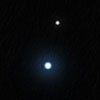Double Star of the Month
Delta Orionis
AKA: Mintaka, STFA 14. Position: 05 hr 32.0 min -00 deg 18 min.
Due south at 21.54 (GMT) on 15 January 2020.
Image credit: Jeremy Perez (http://www.perezmedia.net/beltofvenus/)
This star is very easy to find, it is the right-most (or more accurately the most westerly) of the three stars of Orion’s belt. The main star is bright at magnitude 2.4 and while the gap is large at 56″ (almost a minute), the secondary (called C as there is a very dim (14 mag.) companion which is closer) is only 6.8 and can be hard to see in the glare of its bright neighbour. The primary is usually described as being pale yellow or yellow-white, but the secondary has been called purple or violet as well as blue-white or pale blue. It was first seen by William Herschel in October 1779 and described by him as considerably unequal, white and bluish red. The two stars are not physically connected and it is an optical double. Under very high magnification in a good telescope the primary may look rod-like as it has a very close companion (only 0.3″) which is almost as bright with a magnitude of 3.8 which was only discovered in 1978. The other two stars in Orion’s belt are double stars as well. The left-hand (or eastern) one, Alnitak or Zeta Orionis, is a rather tight double with a separation of 2.2″ between the 1.9 mag. primary and the relatively bright 3.7 mag. secondary, you will need fairly high magnification. The colours are yellow and yellow-white. There is a much fainter (mag. 9.6) companion a whole degree away. The middle one, Alnilam or Epsilon Orionis, has a huge separation of 179″ (almost three degrees) but the secondary is a very faint mag. 11.3 (the primary is mag. 1.7). The main star is blue-white and the secondary is nondescript.
